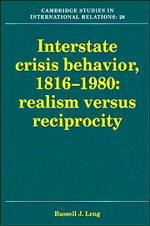Book contents
- Frontmatter
- Contents
- List of figures
- List of tables
- Preface
- 1 REALIST AND PSYCHOLOGICAL PERSPECTIVES
- 2 METHODOLOGY
- 3 THE CRISIS STRUCTURE AND WAR
- 4 PATTERNS OF BEHAVIOR
- 5 STRUCTURE, BEHAVIOR, AND OUTCOMES
- 6 INFLUENCE TACTICS
- 7 INFLUENCE STRATEGIES
- 8 RECIPROCATING INFLUENCE STRATEGIES
- 9 SUMMARY AND CONCLUSION
- EPILOGUE: THE 1990–1991 CRISIS IN THE PERSIAN GULF
- Appendices
- Notes
- References
- Index of names
- Index of subjects
- Titles in the series
8 - RECIPROCATING INFLUENCE STRATEGIES
Published online by Cambridge University Press: 05 February 2010
- Frontmatter
- Contents
- List of figures
- List of tables
- Preface
- 1 REALIST AND PSYCHOLOGICAL PERSPECTIVES
- 2 METHODOLOGY
- 3 THE CRISIS STRUCTURE AND WAR
- 4 PATTERNS OF BEHAVIOR
- 5 STRUCTURE, BEHAVIOR, AND OUTCOMES
- 6 INFLUENCE TACTICS
- 7 INFLUENCE STRATEGIES
- 8 RECIPROCATING INFLUENCE STRATEGIES
- 9 SUMMARY AND CONCLUSION
- EPILOGUE: THE 1990–1991 CRISIS IN THE PERSIAN GULF
- Appendices
- Notes
- References
- Index of names
- Index of subjects
- Titles in the series
Summary
Reciprocity serves as the guiding principle for social exchange in anarchic systems, and, in the international system, with its assumption of the sovereign equality of states, the reciprocity norm lies at the heart of diplomacy and international law.
Empirical evidence of the prevalence of reciprocating, or tit-for-tat behavior has appeared in a number of studies of interstate behavior (see Chapter 6). In the course of this investigation, we have found evidence of a marked degree of reciprocity in responses to both accommodative and coercive influence attempts (Chapter 6). We have found also that states employing Reciprocating influence strategies achieved the greatest degree of success in obtaining successful peaceful outcomes to militarized crises (Chapter 7). In short, an examination of the crises in the sample suggests that states in crises tend to interact in a reciprocal manner, and that when states base their influence strategies on that assumption, they are more likely to be successful.
This chapter takes a closer look at Reciprocating influence strategies and the reasons for their success. The results found in Chapter 7 are consistent with a previous empirical study of interstates crises by Leng and Wheeler (1979), but most of the research on the relative effectiveness of different types of influence strategies has appeared in interpersonal, or computer programming, experiments with Prisoner's Dilemma (PD) games. A variety of strategies for eliciting cooperation have been examined in these experiments, with the Tit-for-Tat (TFT) and GRIT strategies described in Chapter 7 competing for the status of being viewed as most effective overall (see Patchen, 1987).
- Type
- Chapter
- Information
- Interstate Crisis Behavior, 1816–1980 , pp. 164 - 190Publisher: Cambridge University PressPrint publication year: 1993

